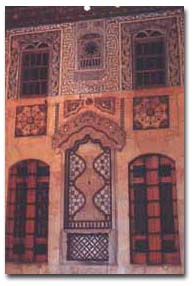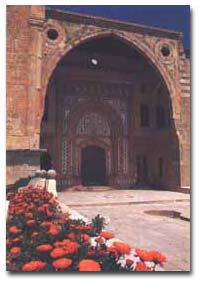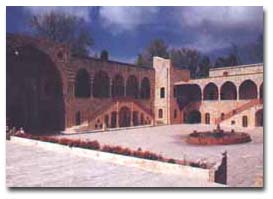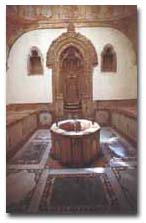BEITEDDINE |
The road to Beiteddine leaves the coastal highway 17 Kilometers beyond Beirut, just a few Kilometers after the town of Damour. From there it climbs quickly along the beautiful Damour river valley for 26 Kilometers to an elevation of 850 meters at Beiteddine. The most spectacular view of the palace and its surroundings is from the village of Deir el Qamar (Monastery of the moon), Five Kilometers before beiteddine. The Beiteddine palace complex, Lebanon’s best example of early 19th century Lebanese architecture, was built over a thirty-year period by Emir Bechir el-Chehab, who ruled Mount-Lebanon for more than half a century. 
|
BEITEDDINE- SURROUNDED BY
HISTORY |
| In the Middle Ages Lebanon was divided up into fiefs governed by emirs or hereditary sheikhs. But in the early years of the 17th century, Emir Fakhr Ed-Dine Maan (d.1635) succeeded in extending his power throughout these princedoms and eventually ruled an area corresponding to present-day Lebanon. |
|
His first capital was at Baaqline but because of a chronic water shortage, he was forced to move to Deir el-Qamar where there were copious springs. When the Maan dynasty died out at the end of the 17th century, the land was inherited by the emirs of the Chehab II who decided to leave Deir el Qamar and to construct his own palace at Beiteddine (House of Faith), a Druze hermitage which today is part of the palace. In 1812 Emir Bechir obliged each of his able-bodied male subjects to provide two days of unpaid labor in order to ensure a plentiful supply of water at his new seat of government. Within two years the project was completed. |
The palace remained the emir’s residence until his forced exile in 1840.After the ottomans suppressed the emirate in 1842 the building was used by the Ottoman authorities as the government residence. Later, under the French Mandate following World War I, it was used for local administrative purposes. |
The General Directorate of Antiquities carefully restored Beiteddine to its original grandeur after it was declared a historic monument in 1934.Beginning in 1943,the year of Lebanon’s independence; the palace became the summer residence of the president. Bechara el-Khoury was the first president to use Beiteddine and he brought back the remains of Emir Bechir from Istanbul, where he had died in 1850. Today Beiteddine to its museums and its gardens is one of Lebanon’s major tourist attractions. Qualified guides are available for your tour through this monument, which is open daily. A visit to Beiteddine is ideally combined with near by Deir al – Qamar |
 Mosaics of colored marble |
VISITING THE
PALACE |
| Dar el-Baraniyyeh,
the Outer Section of the Palace (A). |
On the approach to the palace a large parking area offers some of the best views of the buildings and grounds. The main entrance (1) leads to a 107 x 45 meter courtyard, al-Midan (2), where horseman, courtiers and visitors used to meet for various gatherings. From here, too, the emir would leave with his retinue in solemn procession, either for war or for the hunt. On the ground floor is a museum (3), inaugurated on May 1,1991. Through photographs, documents and manuscripts, it tells the life story of Kamal Jumblat, Member of Parliament, cabinet minister and Druze leader. Along the right side of this court is a two-story wing, Al-Madafa, which was once used for receiving guests .It was the custom that anyone of rank would keep open house for passersby and that a visitor would not be asked for his identity or the purpose of this journey until he had been there for three days. |
 Dar el-Harim façade |
A staircase 4 leads to the upper floor, which was entirely restored in 1945 using old documents as a guide. Before the recent war in Lebanon this wing housed am important museum of the feudal perod. Today it is the location of the Rashied Karami Archaeological and Ethnographic Museum (5). The large collection includes pottery from the Islamic period. In the first room on this floor is a complete model of Beiteddine, which will help the visitor visualize the size and configuration of the buildings. More rooms, devoted to Ethnographic subjects, contain a collection of ancient and modern weapons, as well as costumes of the feudal period. |
Dar el-Wousta, the Middle Section of the
Palace (B). |
The entrance to the central section of the palace is from a double stairway (6) at the far western end of he courtyard, where a bust of Kamal jumblat stands. From this point on, the impressive but austere appearance of the outside court and buildings gives way to the delightful architecture and greenery that has given Beiteddine its nickname of Lebanon’s Alhambra. From the main entrance of this wing (7), a vaulted passage at the top of the double staircase turns to the right, towards the apartments of the Hamad Sheikhs of the Shouf who were responsible for the protection of the palace (8). A turn to the left brings you to the offices of the Emir’s Ministers. |
The wing opens out onto an elegant courtyard (9) whose fountains accent the graceful arcades on three sides of the court. Followings a tradition dear to Lebanese architecture, the fourth side of the court is completely open in order to provide full enjoyment of the countryside. |
The Luxurious rooms along this court, the corners of which are occupied by wooden balconies or kiosks called Comandaloune, are richly decorated with mosaics and parquetry and fitted with the best of traditional oriental furnishings. These rooms served as offices and reception salons for the Emir’s minister, secretaries and members of his court. One of the rooms is attributed to the Emir’s Minister, Boutros Karami (10). |

The courtyard of Dar el-Wousta |
|
The walls and ceilings are covered in intricately carved and painted wood, embellished with Arab calligraphy. The marble fountains and panels were ingeniously designed to cool the surroundings in summer, while brass braziers stood ready to Warm the chilly stone interiors in winter .The northern side of this court, Dar el-Kataba (11), served as offices for the secretaries. |
||
Dar el
Harim, the private apartments (C). |
At the far end of this courtyard rises the Dar el Harim, composed of a large and richly decorated façade, the Upper Harem (13), the reception room or salamlik, the lower Harem, the kitchens and the baths. The monumental archway opens on the left to the reception wing, which is made up of a waiting room and a hall. These are by far the most ornate rooms in the palace. The waiting room has a single column supporting the vault and is known as the "room of the column" (14). The reception hall itself, or Salamlik (15), is built on two levels, the first notable for a fine mosaic floor and walls covered with carved marble, sculptures and inscriptions. One of these inscriptions reads:" The homage of a governor towards God is to observe justice, for an hour of justice is worth more than a thousand months of prayer". Emir Bechir sat on the raised platform at the bay end of the room, smoking his long pipe or nargileh, as he dispensed justice with dignity and absolute power. Here the Emir held court and carried out the business of his emirate. On the right of the entry door is the Upper Harem, with the so-called "Lamartine’s room" (16) and another important room called Mahkamat, or tribunal (17). The corridor leads to the lower Harem with the private apartments of the emir and his family set around a courtyard enclosed on four sides. Two liwans on the sides of this court allowed the family members to enjoy the fresh air (18). On the angle of the Upper and the Lower Harems are the kitchens (19) where servants prepared the daily meals for more than 500 people. The food was taken from there to the reception and living areas where it was placed on trays set in front of the divans of the notables and their visitors. From the balconies of the Dar el Harim, which look out across a vast terraced valley, can be seen the most spectacular view of the place’s surroundings. |
 Hammam: The cold room |
Hammam, or
baths
At the northern edge of the Dar el Harim section in the "hammam", (20), one of the most beautiful in the Arab world. Following a tradition dating to Roman times, these baths comprise a cold room or frigidarium, used for undressing and for relaxation before and after the bath. In this reception room one could discuss politics or literature or listen to the latest rumors. The second section of the baths comprises the lukewarm room, or tepidarium. This was used for massages and served as a transition between the cold and warm sections. The third part comprised the warm rooms or caldarium. The paving stones of the baths were supported by brick pillars and vaults with heated air passing underneath. |
|
| Beyond the baths id the
tree-shaded tomb of sitt Chams, the first wife of the emir (21). She is buried
in a domed tomb surrounded by cypress trees in the corner of the gardens. When
the ashes of the emir were brought back from Istanbul in 1947 they were placed
in the same sepulcher |
The Stables and the Mosaic
Exhibition. |
Dar el Wousta and Dar el Harim are built over a series of recently and beautifully restored vaulted stables that used to accommodate 600 horses and their riders, as well as the 500 foot-soldiers of the emir’s guard. Today these stables hold an extensive collection of Byzantine mosaics. The largest of them come from the ruins of a Byzantine church in the coastal city of Jiyyeh, south of Beirut. The Greek inscriptions appearing on the mosaics date them to the 5th and 6th centuries A.D. Mosaics from other sites are displayed in these stables and in the adjacent gardens. Near the mosaic museum is the hermitage, or khaalwa, a place of religious seclusion for the Druze. This large room, in existence long before Emir Bechir built the palace, has been restored and is open to visitors. |
Palace of Emir Amine A palace was built for each of the emir’s three sons, Qassim, Khalil and Amine. The palace of Emir Qassim, now in ruins, is perched on a promontory facing the great palace. Today Emir Khalil’s palace is used as the serial of Beiteddine, the seat of local administration. As for the palace of Emir Amine, which dominates the Beiteddine complex, it was beautifully restored and converted into a luxury hotel by the Ministry of Tourism. Now called the Mir Amine Palace, most of the hotel’s 24 rooms open onto private terraces and a hanging garden. |
|
Within walking distance from Mir Amine Palace is the summer residence of the Maronite Archbishop of Sidon, for merely Emir Bechir’s country house. Some of the original architectural elements remain, including a beautiful stone doorway covered with a pagoda-shaped roof. This elegant doorway is reached by a high circular staircase easily visible from a distance. |
| Information Collected From The Ministry of Tourism |